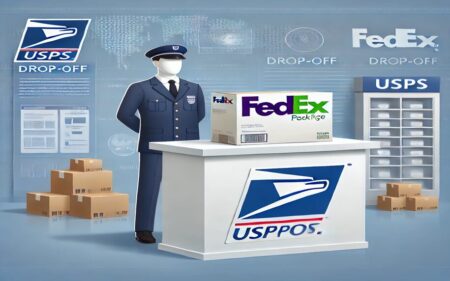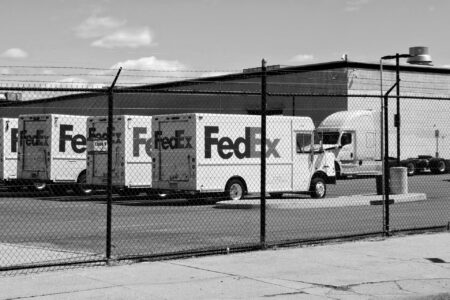Sending packages can be confusing, especially when you’re dealing with different shipping companies. You might wonder if you can drop off a FedEx package at your local post office or what happens if you mix up your packages. Don’t worry – we’re here to help clear things up.
In this guide, we’ll explore the relationship between USPS and FedEx, and answer the burning question: Does USPS accept FedEx packages?
Generally, USPS doesn’t accept FedEx packages in their original FedEx packaging. But there’s more to the story, and we’ll dive into all the details in this article.
What’s the deal with USPS and FedEx packages?
Let’s cut to the chase: USPS normally doesn’t handle FedEx shipments that come in FedEx-branded envelopes or boxes. It’s not that they have a vendetta against FedEx – it’s just not part of their standard operating procedure.
However, don’t throw in the towel just yet. The relationship between these two shipping giants is more complex than you might think. As a matter of fact, USPS and FedEx have been in cahoots since 2001, working together in ways that might surprise you.
It’s worth noting that while the general rule is “no FedEx packages at USPS,” there are always exceptions to the rule. Some USPS locations, particularly those offering packing and shipping services are more flexible. If you’re in a pinch, it’s worth checking with your local post office to see what their specific policies are. After all, rules can vary from one location to another.
How do USPS and FedEx collaborate?
Well, believe it or not, USPS and FedEx have a long-standing partnership that benefits both parties.
Here’s the lowdown:
- Network sharing: USPS taps into FedEx’s extensive global network, especially for international shipments.
- Last-mile delivery: FedEx has used USPS’s strong local delivery capabilities for its SmartPost service (more on this later).
This collaboration allows both carriers to play to their strengths. FedEx brings its massive air fleet to the table – we’re talking about the largest non-passenger aircraft fleet in the world. On the flip side, USPS contributes its unparalleled local delivery network.
As of now, this partnership is set to continue until 2024, according to recent reports.
However, it’s important to understand that this collaboration doesn’t mean you can simply drop off your FedEx package at any USPS location. The relationship between these carriers is more complex than that. While they do work together in certain ways, USPS doesn’t directly handle FedEx shipments anymore.
Can you use a FedEx box for USPS shipping?
Now, here’s where things get a bit tricky. The short answer is no, you can’t use a FedEx box to ship via USPS. But let’s break this down a bit more:
- FedEx branding: USPS won’t accept packages in FedEx-branded boxes or envelopes. It’s a matter of brand integrity and avoiding confusion.
- Repackaging required: If you have a FedEx box and want to ship with USPS, you’ll need to repackage your item in a plain box or USPS-approved packaging.
Remember, each carrier has its own packaging for a reason. Using the right packaging not only ensures your package will be accepted but also helps it move through the shipping process more smoothly.
Why might FedEx hand off your package to USPS?
If you’ve ever tracked a FedEx package only to find it suddenly in the hands of USPS, you’re not alone. This handoff used to be a common occurrence, particularly with the SmartPost service we mentioned earlier.
Here’s why this happened:
- Cost-effectiveness: For smaller, less time-sensitive packages, it was often cheaper for FedEx to leverage USPS’s extensive local network.
- Last-mile efficiency: USPS excels at delivering to every address in the US, making them ideal for the final leg of delivery.
However, as of 2021, FedEx has phased out this practice. They’ve rebranded SmartPost as FedEx Ground Economy and now handle all deliveries themselves. This move aims to cut costs and improve efficiency for the carrier.
Is it legal for FedEx to use your mailbox?
Here’s an important point to remember: It is not legal for FedEx (or any other carrier) to use your USPS mailbox. In fact, it’s against federal law for anyone but USPS and you, the resident, to place items in or remove items from your mailbox.
This might seem like a strange rule, but it’s all about protecting USPS’s service. The mailbox is considered federal property, and this regulation helps ensure the security and efficiency of mail delivery.
So, if you see a FedEx driver approaching your mailbox, don’t be surprised if they make a beeline for your doorstep instead. They’re just following the law!
What happens if you accidentally put a FedEx package in a USPS drop box?
We’ve all had those moments of absent-mindedness. If you’ve accidentally dropped a FedEx package into a USPS drop box, don’t panic. Here’s what typically happens:
- USPS identification: The post office will identify the package as non-USPS.
- FedEx notification: USPS will request FedEx to pick up the package.
- Potential delays: This mix-up will likely cause delays in your package’s journey.
- Tracking issues: Your FedEx tracking number won’t work until FedEx reclaims the package.
In some cases, USPS might charge FedEx a “Postage Due” fee for the inconvenience. This cost could potentially be passed on to you or the recipient.
It’s important to note that if you try to drop off a FedEx package at a USPS location, you might be in for a bumpy ride. There’s no guarantee of immediate processing, and your package could end up in limbo while waiting for FedEx to retrieve it from the post office. This could lead to significant delays in your shipment reaching its destination.
To avoid this hassle, always double-check the carrier logo on your package before dropping it off. A moment of attention can save you a world of trouble!
How has the FedEx SmartPost service evolved?
The evolution of FedEx SmartPost is a perfect example of how the shipping industry is constantly adapting. Let’s take a trip down memory lane:
- Early days: SmartPost was introduced as a cost-effective solution for businesses shipping small, light packages.
- USPS collaboration: The service initially relied heavily on USPS for final delivery.
- Transition period: FedEx gradually began handling more of the delivery process themselves.
- Rebranding: In 2021, SmartPost was rebranded as FedEx Ground Economy.
- Current state: FedEx now handles the entire delivery process without USPS involvement.
This evolution reflects FedEx’s efforts to streamline their operations and maintain control over the entire shipping process. It’s a significant shift in the industry, showcasing how major carriers are adapting to changing market demands and technological advancements.
How did FedEx SmartPost work with USPS?
In its heyday, FedEx SmartPost was a unique collaboration between FedEx and USPS. Here’s how it worked:
- FedEx would pick up the package from the sender and transport it to the nearest USPS facility.
- USPS would then handle the “last mile” delivery, bringing the package to its final destination.
This system allowed FedEx to leverage USPS’s extensive local delivery network, particularly in residential areas. It was especially popular for e-commerce businesses shipping lightweight packages.
However, as mentioned earlier, FedEx has since phased out this service in favor of handling the entire delivery process themselves. This change aims to improve efficiency and give FedEx more control over the customer experience.
What are the key differences between USPS and FedEx?
While USPS and FedEx might seem similar at first glance, they have some fundamental differences. Let’s break them down:
- Ownership: USPS is a government agency, while FedEx is a private corporation.
- Service focus: USPS specializes in mail and small packages, whereas FedEx is known for its express and large package delivery.
- Global reach: FedEx has a more extensive international network, though USPS does offer international shipping.
- Pricing structure: USPS often has lower rates for smaller packages, while FedEx can be more cost-effective for larger or express shipments.
- Tracking capabilities: FedEx is renowned for its advanced tracking system, though USPS has made significant improvements in recent years.
Here’s a comparison of the main services offered by FedEx and USPS:
| Service Type | USPS | FedEx |
|---|---|---|
| Standard Delivery | First-Class Mail, USPS Retail Ground | FedEx Ground |
| Express Delivery | Priority Mail Express | FedEx First Overnight, FedEx Priority Overnight |
| International Shipping | Global Express Guaranteed, Priority Mail Express International | FedEx International Priority, FedEx International Economy |
| Flat Rate Options | Priority Mail Flat Rate | FedEx One Rate |
| Saturday Delivery | Included in standard service | Available for an additional fee |
As you can see, both carriers offer a range of services to meet different shipping needs. The best choice depends on your specific requirements, such as delivery speed, package size, and budget.
Are there any size or weight limitations for packages shipped through USPS?
When it comes to shipping with USPS, size and weight do matter. Here are some general guidelines:
- Maximum weight: 70 pounds for most services
- Maximum size: 130 inches in combined length and girth for most services
However, these limits can vary depending on the specific service you’re using. For instance, USPS Retail Ground has a maximum weight of 70 pounds, while First-Class Mail packages are limited to 13 ounces.
It’s always a good idea to check the USPS website for the most up-to-date information on size and weight restrictions for your chosen service.
How do you choose between USPS and FedEx for shipping?
Choosing between USPS and FedEx isn’t always straightforward. Here are some factors to consider:
- Package size and weight: USPS is often more economical for smaller, lighter packages.
- Delivery speed: If you need express delivery, FedEx might be your best bet.
- Destination: For domestic deliveries, especially to rural areas, USPS can be more efficient.
- Budget: Compare rates for your specific package and destination.
- Tracking needs: If detailed tracking is crucial, FedEx might have an edge.
- Insurance: Both offer insurance, but coverage and costs may differ.
Remember, there’s no one-size-fits-all solution. The best choice depends on your specific shipping needs and circumstances.
What are the pros and cons of using USPS vs. FedEx?
To help you make an informed decision, let’s weigh the pros and cons of each carrier:
| Aspect | USPS | FedEx |
|---|---|---|
| Pros | – Often cheaper for small packages – Excellent for domestic delivery – Saturday delivery at no extra cost – Free package pickup |
– Superior tracking – Faster for express shipments – Better for large packages – More international options |
| Cons | – Less robust tracking – Slower for some services – Limited international options |
– Generally more expensive – Extra fees for residential delivery – Saturday delivery costs extra |
As you can see, each carrier has its strengths and weaknesses. Your choice should align with your specific shipping needs and priorities.
Are there any alternatives to USPS and FedEx?
While USPS and FedEx are major players in the shipping industry, they’re not the only options. Here are some alternatives worth considering:
- UPS: Another major carrier with extensive domestic and international services.
- DHL: Particularly strong for international shipping.
- Regional carriers: Depending on your location, regional carriers might offer competitive rates and services.
- Shipping consolidators: These services combine shipments from multiple customers to secure lower rates.
Each of these options has its own set of pros and cons, so it’s worth doing your research to find the best fit for your needs.
How can businesses optimize their shipping strategy using both carriers?
For businesses, leveraging both USPS and FedEx can lead to significant cost savings and improved customer satisfaction. Here’s how you can optimize your shipping strategy:
- Diversify carriers: Use USPS for smaller, less time-sensitive packages and FedEx for larger or express shipments.
- Negotiate rates: If you ship in volume, don’t hesitate to negotiate rates with both carriers.
- Use shipping software: Tools like ShipStation or Shippo can help you compare rates and streamline your shipping process.
- Consider hybrid services: Some third-party logistics providers offer services that combine the strengths of multiple carriers.
- Analyze data: Regularly review your shipping data to identify trends and opportunities for optimization.
Remember, the key is to be flexible and adapt your strategy based on your evolving business needs and market conditions.
What does the future hold for USPS and FedEx collaboration?
The shipping industry is constantly evolving, and the relationship between USPS and FedEx is no exception. While their current agreement extends to 2024, the future beyond that is uncertain.
Some potential developments to watch for include:
- Technological advancements: Both carriers are investing heavily in automation and AI, which could reshape their operations and collaborations.
- Regulatory changes: Any shifts in postal regulations could impact how USPS and FedEx work together.
- Market pressures: Increasing competition from other carriers and shipping alternatives might influence future partnerships.
- Sustainability initiatives: As both carriers strive to reduce their carbon footprint, we might see new collaborations focused on eco-friendly shipping solutions.
While we can’t predict the future with certainty, it’s clear that the shipping landscape will continue to evolve. Staying informed about these changes can help you make the best shipping decisions for your needs.
Key Takeaways
Here are the most important points to remember from this article:
- USPS generally doesn’t accept FedEx packages in their original packaging.
- FedEx and USPS have a business relationship, but this doesn’t mean you can use their services interchangeably.
- Never put a FedEx package in a USPS mailbox – it’s against federal law and can cause delays.
- If you accidentally put a FedEx package in a USPS drop box, it will likely cause delays in delivery.
- FedEx SmartPost, which used USPS for final delivery, has been phased out and replaced with FedEx Ground Economy.
- USPS often works better for smaller, lighter packages, while FedEx may be more suitable for larger or express shipments.
- Both carriers have their strengths: USPS is often cheaper for small packages, while FedEx offers superior tracking.
- Always use the correct packaging for each carrier to avoid confusion and potential shipping issues.
- For businesses, using a mix of both carriers can often lead to cost savings and improved efficiency.
- Stay informed about carrier policies and services, as the shipping industry is constantly evolving.











My package FedEx Track.#61299998825470338516 was left by mistake in the USPS service and has been with you for 2 weeks at the MID NY Distribution Center, without movement…what should I do or should you help!?
For more than a month, a package sent via FedEx, due to a mistake by postal workers, ended up at the MID NY Distribution Center without moving. Calls and emails do not help.
Contact USPS at 1-800-275-8777 with your tracking number to request an update. Also, contact FedEx to report the issue and ask for assistance. If unresolved, file a claim with FedEx.
Call USPS at 1-800-275-8777 to escalate to Consumer Affairs and file a Missing Mail Request at USPS Missing Mail. Contact FedEx to request an investigation or file a claim. If unresolved, file a complaint with the USPS OIG at USPS OIG.